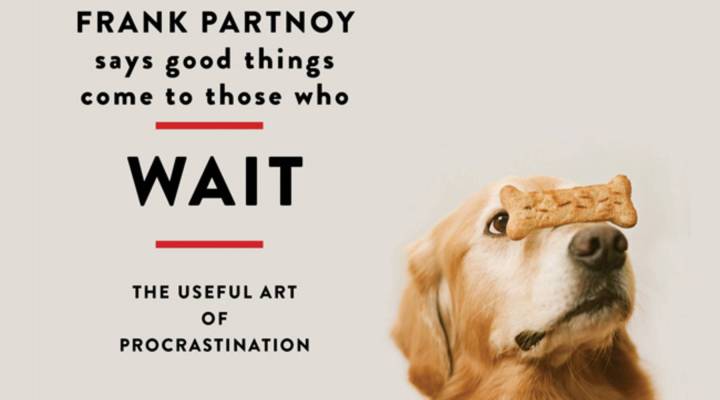
Why you should delay: The upsides to procrastination
Why you should delay: The upsides to procrastination

Tess Vigeland: It took me a long time to write this lede to the next part of our show. I put it off. Delayed until the last-possible minute. Just couldn’t get myself to focus on it. And perhaps we are all better for that. Because now it’s brilliant!
Wouldn’t you agree? Frank Partnoy would. He’s a professor of law and finance at the University of San Diego School of Law and author of the new book: “Wait: The Art and Science of Delay.” I thought about making him wait longer to join us, but with no further delay possible… Frank, welcome to the program.
Frank Partnoy: Thanks so much.
Vigeland: First of all, as one of the worst procrastinators on the face of the earth, let me thank you for saying this is OK.
Partnoy: I’m here to tell you you’re doing just the right thing. Instead of procrastination, you should call it managing delay. You’re not procrastinating, you’re managing delay. It’s a very important lesson in life and business, which is to delay gratification. People are better off and they’re happier, they make better decisions, when they’re able to delay gratification. And that’s true whether or not the time frame is milliseconds long or months long or years long. This is a skill that we learn as children and it carries us through — that helps us later in life.
Vigeland: But that just doesn’t fit with the way we think of things these days. Everything is about speed right now, isn’t it?
Partnoy: It is. And the crush of technology is ruining our decision making. The relentless of email and social media and the 24-hour news cycle is speeding up our decisions. And the best thing to do is just to take a breath and be cognitively aware of what your own limitations are. Say, “You know what, I live in a fast-paced world and my computer screen is flashing at me and I’m subject to all this stimulus. What I need to do every once in a while is just take a break, take a deep breath, look outside, stare out into the distance and that that will help us make better decisions.”
Vigeland: Yeah, but then someone is going to walk by my office and see me staring out into the distance and wonder why I’m not working.
Partnoy: Well if you read “Wait” — show them “Wait” — you’ll have a good excuse to show them exactly what it is you’re doing and why.
Vigeland: You do talk in the book about not just individuals, but how businesses/corporations can use this concept of waiting — and have used it — to some success, including 3M and the Post-it note.
Partnoy: Yes. The Post-it note is a story that’s told everywhere, in every business case book. It’s even in my daughter’s sixth grade science book. It’s often told as an epiphany story — this sudden discovery. But if you look at the truth of the Post-it story, it’s a story that developed over a long, long period of time — involving two men who were tinkerers as kids, who got jobs at 3M; then called Minnesota Mining, known as “Mother Mining,” which was a very nurturing company that gave them 15 percent free time to develop their crazy ideas that might never be monetized. The process of developing the Post-it took a total of 12 years. So one of the things I wanted to try to show in the book is that companies who are successful innovators are willing to wait and that the epiphany story is often not true. Issac Newton did not get hit on the head by an apple. Thomas Edison did not suddenly invent the light bulb overnight. And companies need to understand this and devote themselves to the long haul, and the long haul means years and years and years before they’ll have true innovation.
Vigeland: Then why is it, do you think, that the myth persists that these are all kind of flashes that happen?
Partnoy: We want that to be true. We want it to be easy to innovate. We want to believe that we’ll be able to invent the next mousetrap suddenly and that the first mover advantage is always the right way. It’s a very attractive, almost romantic story about corporate innovation. The only problem with it is that it’s not true. Sometimes the first mouse is in great danger of getting eaten by a cat and so the second mouse gets the cheese. There’s a lot of academic literature that shows that there’s a second-mover advantage in a lot of business, that it’s often better to wait.
Vigeland: All right. Next time my producer asks me why my feature isn’t done, I’m just going to tell him that it gets better and better to write it.
Partnoy: And at the last minute you’ll come through with some brilliant insight and you’ll produce a piece just like this one.
Vigeland: Frank Partnoy is the author of “Wait: The Art and Science of Delay.” Thanks so much.
Partnoy: Thank you.
There’s a lot happening in the world. Through it all, Marketplace is here for you.
You rely on Marketplace to break down the world’s events and tell you how it affects you in a fact-based, approachable way. We rely on your financial support to keep making that possible.
Your donation today powers the independent journalism that you rely on. For just $5/month, you can help sustain Marketplace so we can keep reporting on the things that matter to you.












